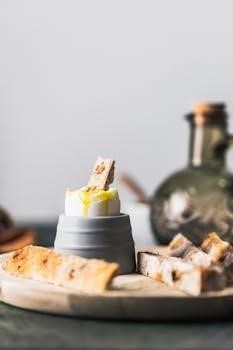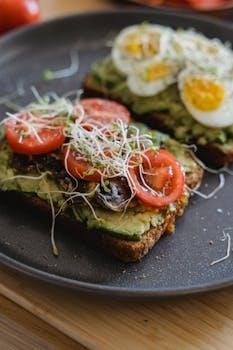Hard-boiled egg cookers are convenient kitchen appliances designed to simplify the process of cooking eggs. These devices provide a quicker and more consistent method compared to traditional stovetop boiling‚ ensuring perfectly cooked eggs every time.
What is a Hard Boiled Egg Cooker?
A hard-boiled egg cooker is an electric appliance specifically designed to cook eggs using steam. It typically consists of a base with a heating element‚ a water reservoir‚ an egg holder‚ and a lid. The device works by heating a small amount of water in the reservoir‚ which then creates steam to cook the eggs placed on the holder above. These cookers are designed to be user-friendly‚ often including features such as an automatic shut-off function and a buzzer to signal when the eggs are done. They are versatile‚ capable of producing soft‚ medium‚ or hard-boiled eggs‚ and some models also offer options for poaching or making omelets. The primary goal of these devices is to eliminate the guesswork and inconsistency often associated with stovetop egg boiling‚ providing perfectly cooked eggs with minimal effort.

Preparing the Egg Cooker
Before cooking‚ proper preparation is essential. This involves adding the correct amount of water to the reservoir and carefully placing eggs on the designated holder for even cooking.
Adding Water to the Reservoir
The initial step in using your egg cooker involves adding the correct amount of water to the reservoir. Most egg cookers come with a measuring cup that indicates the water levels needed for different egg consistencies like soft‚ medium‚ or hard-boiled. For hard-boiled eggs‚ you typically need to fill the measuring cup to the designated “hard” line. Ensure you use cold water for best results. Pour the water directly into the center of the water reservoir. This precise measurement is crucial for achieving your desired egg doneness‚ preventing overcooking and ensuring consistent results. This step also helps in the proper steam generation needed for cooking the eggs.
Placing Eggs on the Egg Holder
After adding the water‚ carefully place the egg holder onto the base of the cooker. The egg holder is designed to securely hold the eggs during the cooking process. Arrange your eggs onto the designated spots on the holder‚ ensuring that they are stable and do not touch each other or the sides of the cooker. Avoid overcrowding the holder‚ as this could lead to uneven cooking. Most cookers hold around 6 to 7 eggs‚ depending on their size. Make sure each egg is properly seated to prevent any issues with heat distribution and ensure even cooking for each egg.

Cooking Process
The cooking process involves setting the cooker to the hard-boiled setting. The device will then use steam to cook the eggs for a specific duration‚ ensuring they are cooked thoroughly.
Setting the Cooker for Hard Boiled Eggs
To begin‚ ensure the egg cooker is plugged into an electrical socket. Then‚ carefully place the egg holder onto the base of the cooker. Fill the measuring cup with the appropriate amount of cold water‚ referring to the device’s instructions for hard-boiled eggs. Pour this water into the water reservoir. Next‚ gently place your eggs onto the egg holder‚ ensuring they do not touch each other or the sides of the cooker. Secure the lid onto the cooker. Finally‚ press the ‘ON’ switch to start the cooking cycle. The cooker will then start the steaming process automatically.
Cooking Time for Hard Boiled Eggs
The cooking time for hard-boiled eggs in an egg cooker varies based on the device and the desired level of doneness. Generally‚ for a standard hard-boiled egg‚ the cooking time ranges from 9 to 10 minutes. Some models may have a built-in timer or an automatic shut-off feature‚ which will indicate when the eggs are ready. The precision thermal sensors in these cookers are designed to prevent overcooking‚ ensuring consistent results. Always refer to your specific egg cooker’s manual for the most accurate cooking time‚ as slight variations may exist between different brands and models.

Post-Cooking Instructions
After cooking‚ turn off the egg cooker and carefully remove the lid. It’s crucial to cool the eggs properly before peeling to prevent damage to the egg white.
Turning Off the Cooker and Removing the Lid
Once the cooking cycle is complete‚ which is often indicated by a buzzer or an automatic shut-off‚ it is crucial to immediately turn off the power switch of your egg cooker. This prevents any further heating and ensures the eggs don’t overcook. With caution‚ carefully remove the lid of the egg cooker. Be mindful of the hot steam that may be released when the lid is opened to avoid any burns. It’s important to use oven mitts or a kitchen towel to protect your hands from the heat. Place the lid aside on a safe surface‚ away from any area where it could cause an accident. The eggs are now ready for the next step in the process.
Cooling the Eggs
After removing the lid‚ the next crucial step is to cool the eggs. This process is important for several reasons‚ including preventing overcooking and making the eggs easier to peel. You can cool the eggs by placing them under cold running water for a few minutes. Alternatively‚ you can transfer the hot eggs to a bowl filled with ice water. This rapid cooling method helps to contract the egg contents‚ making the shell easier to remove. Ensure the eggs are completely cooled before attempting to peel them. This step is vital for achieving perfect hard-boiled eggs that are easy to handle and enjoyable to eat.

Additional Features and Tips
Egg cookers often include measuring cups for precise water levels. Piercing eggs before cooking can prevent cracking. Regular cleaning ensures optimal performance and longevity of the appliance.
Using the Measuring Cup for Water Levels
Most hard-boiled egg cookers come equipped with a measuring cup designed to help you add the correct amount of water for your desired egg consistency. These cups usually have markings or labels indicating the water levels for soft‚ medium‚ or hard-boiled eggs. For medium-boiled eggs‚ you’d typically use about half a cup of water‚ while for hard-boiled eggs‚ approximately three-quarters of a cup is required. Using the precise water level is crucial; slightly under-filling can allow for eggs to cool inside the cooker‚ skipping the ice bath. The markings guide you to achieve the desired yolk firmness by adjusting the water volume‚ ensuring consistent and perfect results with each use. The measuring cup is a very important feature‚ since the amount of water is crucial to the final result.
Piercing Eggs Before Cooking
Piercing the eggs before cooking in an egg cooker is a crucial step that prevents them from cracking or bursting during the cooking process. Many egg cookers come with a built-in egg piercer‚ typically a small pin located at the bottom of the measuring cup or on the base of the device. To pierce an egg‚ gently press the wider end of the egg onto the piercer. This creates a tiny hole‚ allowing air to escape from inside the shell as the egg heats up‚ thus preventing the shell from cracking due to pressure buildup. This simple step ensures that your eggs cook evenly and remain intact. It is VERY important to pierce the eggs to avoid a mess.
Cleaning and Maintaining the Egg Cooker
Proper cleaning and maintenance are essential for prolonging the life of your egg cooker and ensuring its optimal performance. Always unplug the device and allow it to cool completely before cleaning. Most egg cookers have non-electric parts‚ such as the egg holder‚ measuring cup‚ and lid‚ which can be washed in the dishwasher. For the base and the heating element‚ use a damp cloth or sponge to wipe away any residue or mineral deposits. Avoid immersing the base in water. Regular cleaning prevents buildup and keeps your egg cooker ready for use. It is crucial to clean every part‚ especially the heating element‚ to prevent any damage.
